
# 1333 FDC - 1967 5c Urban Planning
Issue Date: October 2, 1967
Quantity: 110,675,000
Printed By: Bureau of Engraving and Printing
Printing Method: Lithographed, Engraved
Perforations: 11
Color: Dark blue, light blue and black
Issued for the International Conference of the American Institute of Planners, this stamp publicizes the importance of urban planning and development.
The American City Planning Institute (ACPI) was founded on May 7, 1917. Later becoming the American Planning Association (APA), the organization promotes urban planning – the building or improving of parks, highways, roads, and residential developments. The early 1900s brought an increased interest in improving American cities and towns. In 1901, New York passed a tenement law requiring buildings that housed three or more families to improve light, air quality, windows, courtyards, and more. The following year, Washington, DC adopted the McMillan Plan, to update the nation’s capital with a focus on parks and monuments. This plan is sometimes considered one of the first examples of the US City Beautiful movement, which encouraged grandeur and beautification in city planning. In 1902, Cleveland formed the Board of City Planning for Ohio Cities. While it wasn’t an official city planning commission, it offered improvement suggestions for the city. In 1907, Hartford, Connecticut, established the first official and permanent city planning commission. Before this, some cities established commissions, but they were dissolved when the projects were completed. The following year, New York staged a congestion exhibit, which highlighted the problems caused by overcrowding in the poor areas of the city. The exhibit toured the country and encouraged many city leaders to start their own commissions on congestion. In 1909, Harvard became the first school to offer courses in city planning – The Principles of City Planning – through its Landscape Architecture Department. On May 21 of that year, Benjamin Marsh opened the first National Conference on City Planning. It brought together some of the nation’s leading urban designers, including Frederick Law Olmsted, John Nolen, and George Ford. In July 1909, Burnham published his Plan of Chicago. After three years of research on how city growth affected people, his plan proposed new parks, lake improvements, and expanded transportation. The plan is still influential to city planning today. In the years to come, other major strides were made in city planning. In 1916, New York adopted one of the first zoning codes in the US, which split the city into zones based on their main activities and established guidelines for each one. On May 7, 1917, the National Conference on City planning convened again. This time the attendees founded the American City Planning Institute, with Frederick Law Olmsted Jr. as their first president. In 1934, another national organization emerged, the American Society of Planning Officials (ASPO), which included not just planning consultants, but planning commissioners, city managers, and other public leaders. The ACPI changed its name to the American Institute of Planners in 1939. In 1978, these two organizations merged to become the American Planning Association. Their stated mission was “for charitable, educational, literary and scientific purposes to advance the art and science of planning and the activity of planning – physical, economic, and social – at the local, regional, state and national levels.” The APA also created the American Institute of Certified Planners, to bestow official certification on professional planners. At the time of its creation, the APA had 13,000 members. Today it has over 40,000, with about 17,000 of them certified by the AICP.Founding of the American Planning Association





Issue Date: October 2, 1967
Quantity: 110,675,000
Printed By: Bureau of Engraving and Printing
Printing Method: Lithographed, Engraved
Perforations: 11
Color: Dark blue, light blue and black
Issued for the International Conference of the American Institute of Planners, this stamp publicizes the importance of urban planning and development.
The American City Planning Institute (ACPI) was founded on May 7, 1917. Later becoming the American Planning Association (APA), the organization promotes urban planning – the building or improving of parks, highways, roads, and residential developments. The early 1900s brought an increased interest in improving American cities and towns. In 1901, New York passed a tenement law requiring buildings that housed three or more families to improve light, air quality, windows, courtyards, and more. The following year, Washington, DC adopted the McMillan Plan, to update the nation’s capital with a focus on parks and monuments. This plan is sometimes considered one of the first examples of the US City Beautiful movement, which encouraged grandeur and beautification in city planning. In 1902, Cleveland formed the Board of City Planning for Ohio Cities. While it wasn’t an official city planning commission, it offered improvement suggestions for the city. In 1907, Hartford, Connecticut, established the first official and permanent city planning commission. Before this, some cities established commissions, but they were dissolved when the projects were completed. The following year, New York staged a congestion exhibit, which highlighted the problems caused by overcrowding in the poor areas of the city. The exhibit toured the country and encouraged many city leaders to start their own commissions on congestion. In 1909, Harvard became the first school to offer courses in city planning – The Principles of City Planning – through its Landscape Architecture Department. On May 21 of that year, Benjamin Marsh opened the first National Conference on City Planning. It brought together some of the nation’s leading urban designers, including Frederick Law Olmsted, John Nolen, and George Ford. In July 1909, Burnham published his Plan of Chicago. After three years of research on how city growth affected people, his plan proposed new parks, lake improvements, and expanded transportation. The plan is still influential to city planning today. In the years to come, other major strides were made in city planning. In 1916, New York adopted one of the first zoning codes in the US, which split the city into zones based on their main activities and established guidelines for each one. On May 7, 1917, the National Conference on City planning convened again. This time the attendees founded the American City Planning Institute, with Frederick Law Olmsted Jr. as their first president. In 1934, another national organization emerged, the American Society of Planning Officials (ASPO), which included not just planning consultants, but planning commissioners, city managers, and other public leaders. The ACPI changed its name to the American Institute of Planners in 1939. In 1978, these two organizations merged to become the American Planning Association. Their stated mission was “for charitable, educational, literary and scientific purposes to advance the art and science of planning and the activity of planning – physical, economic, and social – at the local, regional, state and national levels.” The APA also created the American Institute of Certified Planners, to bestow official certification on professional planners. At the time of its creation, the APA had 13,000 members. Today it has over 40,000, with about 17,000 of them certified by the AICP.Founding of the American Planning Association










